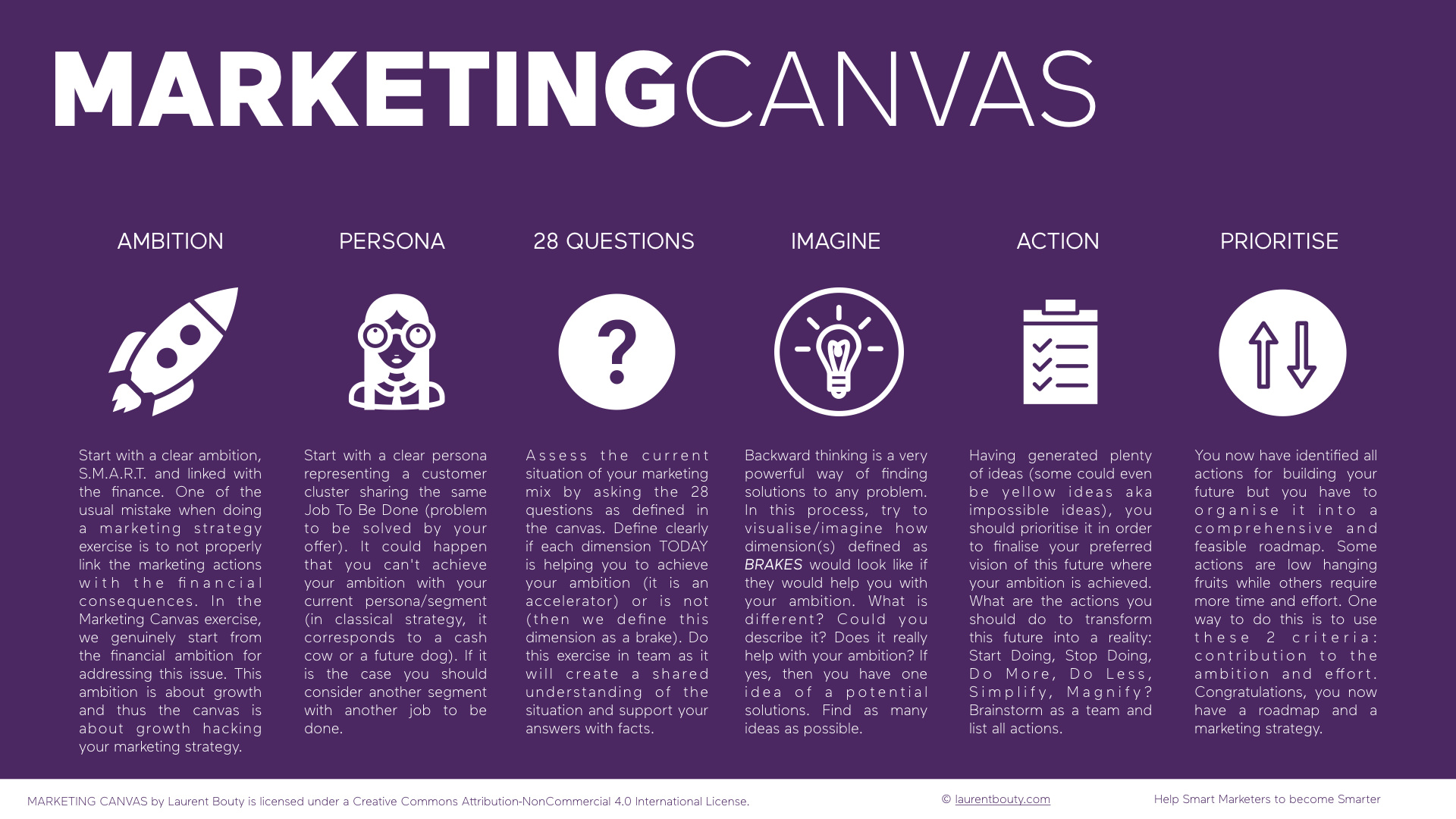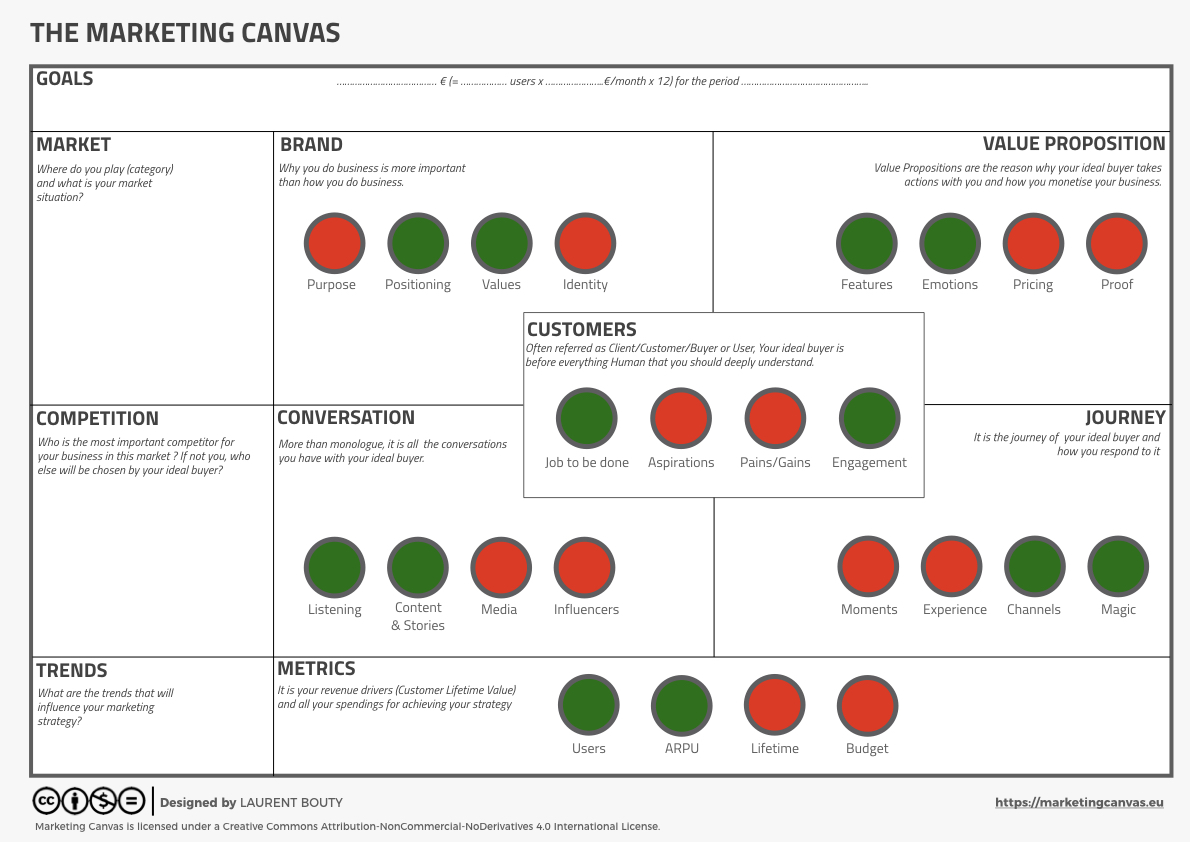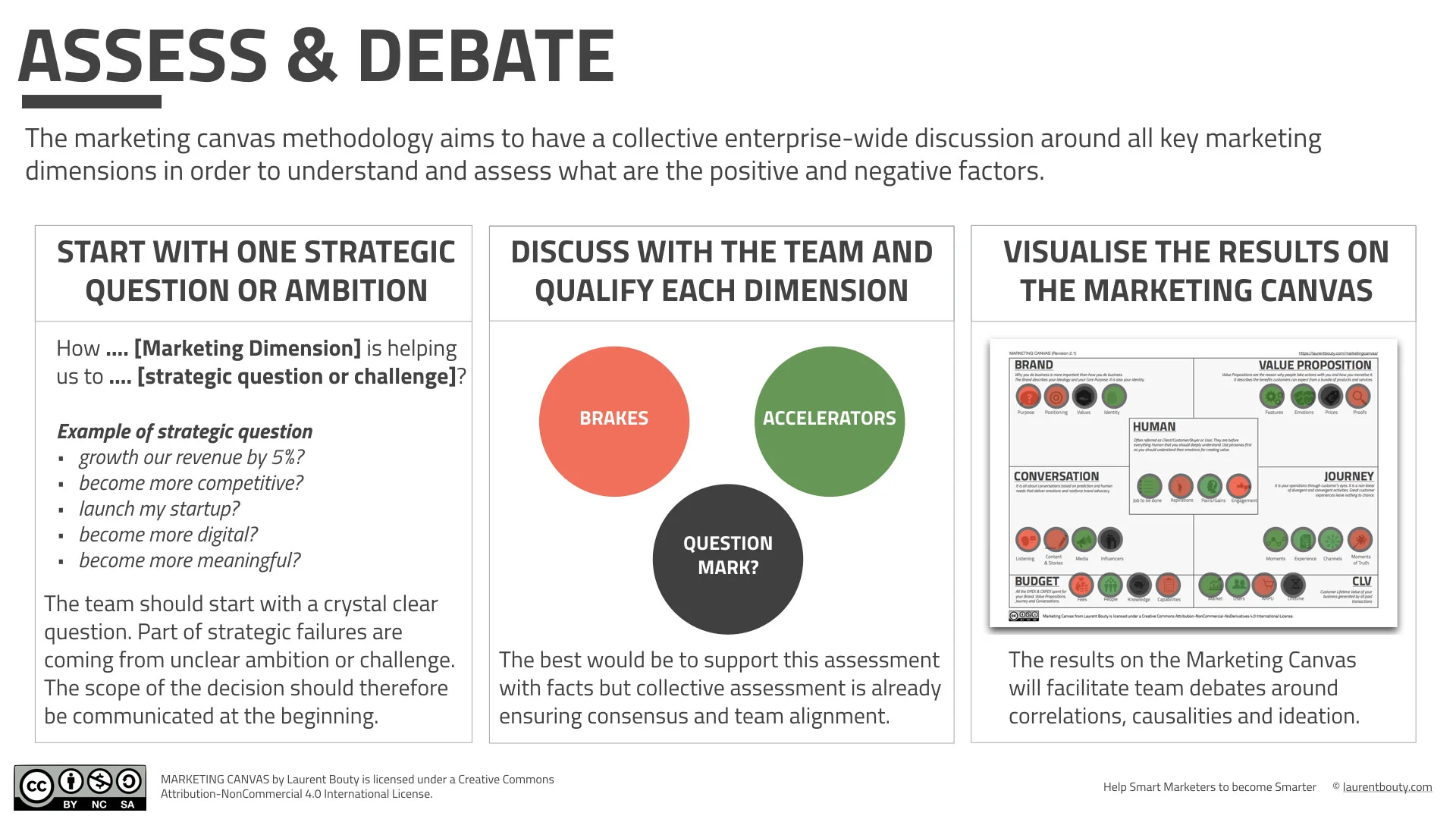Our article delves into the integral role of Visual Identity, a critical sub-dimension of the Marketing Canvas developed by Laurent Bouty. We begin with defining visual identity, as conceived by eminent industry figures like David Aaker and Jeff Bezos, and explain how it goes beyond merely a logo or graphic design. Exploring connections to other sub-dimensions such as Purpose, Positioning, and Values, we highlight its overall impact on your brand's strength. We break down the assessment process into a robust scoring system, identifying potential reasons for various scores and recommending improvement strategies tailored to each scenario. By synthesizing theory with real-world applications, this article offers valuable insights for anyone keen to strengthen their brand's visual identity. Whether you're a seasoned marketer, budding entrepreneur, or simply interested in understanding branding better, our guide aims to make the complex concept of visual identity easy to grasp and apply.
Marketing Canvas - Values
Your values are the translation of your purpose into key behaviors. Most of the commercial activities are delivered through behaviors (from people or from systems). When developing your marketing strategy, you should have Brand values that are fully amplifying your Brand Purpose. It will help your organization to translate your beliefs into action.
Marketing Canvas - Positioning
Marketing Canvas - Purpose
The Marketing Canvas is a tool to build a marketing strategy that consists of six categories, including PURPOSE, which identifies a brand's reason for being and contribution to the world. Purpose-driven brands are more successful in today's world as customers want to engage with brands that align with their values. By starting with the WHY and formulating a purpose-driven brand ideal, businesses can differentiate themselves and build a loyal following. TOMS Shoes and Ben & Jerry's are examples of purpose-driven brands. Having a clear purpose is a key driver of business success, according to a Deloitte survey. It is critical to identify and articulate a brand's purpose to guide its marketing strategy.
Marketing Canvas - Engagement
Marketing Canvas - Pains and Gains
The Pains and Gains sub-dimension in the Marketing Canvas focuses on identifying the constraints (pains) that block your customers from solving their problems and the delights (gains) that you can provide by addressing these constraints. By thoroughly understanding the pain points and potential gains, businesses can deliver solutions that resonate with customer needs and create a more positive overall experience.
Marketing Canvas - Aspirations
Aspirations in the Marketing Canvas help businesses uncover the deeper, often emotional and social goals that customers strive to fulfill through their product or service. Aspirations move beyond functional needs and focus on the personal growth, societal impact, and environmental contribution that customers seek. Identifying these aspirations enables businesses to create stronger emotional connections and long-term relationships with their audience.
Hack: Marketing Canvas and Triple Bottom Line
As Marketers, we are not excused for being complaisant with the world around us. It should have been always the case but today the situation is so critical that we need to take action.
REVISIT STEP 2 - SET YOUR GOAL
The original approach at Step 2 was profit oriented. Indeed, during this step, we recommend to set a financial goal (revenue) before starting step 3 which is the assessment.
The triple bottom line approach (wikipedia) as proposed by John Elkington consists of extending the bottom line concept with sustainable elements. In addition to Profit, Elkington proposed to add Planet and People. The Marketing Canvas Method can be easily hacked for integrating the Triple Bottom Line concept by simply changing the way Goals are set during step 2.
HOW?
At Step 2, you can define goal for Profit (original approach) but also goal for Planet and People. It is not fully clear for me whether a standard framework exists with clear KPIs linking Marketing Strategy and Planet/People elements. You can chose the goals that would specifically work for you when discussing Planet and People topics. Based on a very quick desk research, I identified few topics that could be used for defining objectives for Planet and People. It would be interesting to have your point of views and make this list more robust. Don’t hesitate to comment this post.
LIST OF GOALS FOR PEOPLE AND PLANET
Energy Management: How could you reduce your energy consumption and use more renewable energy when executing your marketing strategy? Goal?
Resource Management: How could you make use of resources for your marketing strategy in such a way that our next generation or in future there are no effects on the resource? Goal?
Waste Management: How could you collect, transport, process or dispose of, manage and monitor various waste materials generated by your marketing strategy? Goal?
Employee Welfare: How could you reinforce employee welfare when executing your marketing strategy? Goal?
Fair Trade: How could you reinforce fairness in your marketing strategy through dialogue, transparency and respect, that seeks greater equity in international trade? Goal?
Cause Marketing: How can you better the society while executing your marketing strategy? Goal?
PROCESS
When you have defined these goals (e.g. CO2), you can apply the Marketing Canvas Method for assessing your current situation (STEP 3). Let’s take 2 examples from the 24 dimensions.:
JOB TO BE DONE (CUSTOMERS): Is the knowledge of your customers’ job to be done helping you from achieving your goals?
FEATURES (VALUE PROPOSITION): Are the features of your value proposition helping you achieve your goals?
By asking these questions, you have interesting discussions about your current ability to achieve these goals (like CO2) or not (Brake or Accelerator).
NEW TEMPLATE
Marketing Canvas - Market and Economic Value
Le Marché dans le Marketing Canvas
Dans l’enthousiasme de travailler sur sa stratégie marketing, on se précipite souvent et oublie l’importance de ce que je considère comme la première étape: la compréhension du marché dans lequel nous allons opérer (startup) ou nous opérons déjà (entreprise existante). Il y a 3 questions importantes à se poser lorsqu’on analyse le marché. C’est questions sont: …
How to connect your ambition with your operations
I had an interesting discussion with @nicolasdebray (Semetis, Academic Director) about the Ambition in the Marketing Canvas Process…
Marketing Canvas - Ambition
Marketing Strategy for Millennials from Marketing Cloud
Marketing Canvas, some tips about the process
Canvas works really well if:
- Start with a clear ambition, S.M.A.R.T. and linked with the finance. One of the usual mistake when doing a marketing strategy exercise is to not properly link the marketing actions with the financial consequences. In the Marketing Canvas exercise, we genuinely start from the financial ambition for addressing this issue. This ambition is about growth and thus the canvas is about growth hacking your marketing strategy.
- Start with a clear persona representing a customer cluster sharing the same Job To Be Done (problem to be solved by your offer). It could happen that you can't achieve your ambition with your current persona/segment (in classical strategy, it corresponds to a cash cow or a future dog). If it is the case you should consider another segment with another job to be done.
- Assess the current situation of your marketing mix by asking the 28 questions as defined in the canvas. Define clearly if each dimension TODAY is helping you to achieve your ambition (it is an accelerator) or is not (then we define this dimension as a brake). Do this exercise in team as it will create a shared understanding of the situation and support your answers with facts.
- Backward thinking is a very powerful way of finding solutions to any problem. In this process, try to visualise/imagine how dimension(s) defined as BRAKES would look like if they would help you with your ambition. What is different? Could you describe it? Does it really help with your ambition? If yes, then you have one idea of potential solutions. Find as many ideas as possible.
- Having generated plenty of ideas (some could even be yellow ideas aka impossible ideas), you should prioritise it in order to finalise your preferred vision of this future where your ambition is achieved. What are the actions you should do to transform this future into a reality: Start Doing, Stop Doing, Do More, Do Less, Simplify, Magnify? Brainstorm as a team and list all actions.
You now have identified all actions for building your future but you have to organise it into a comprehensive and feasible roadmap. Some actions are low hanging fruits while others require more time and effort. One way to do this is to use these 2 criteria: contribution to the ambition and effort. Congratulations, you now have a roadmap and a marketing strategy.
Questions you should ask with the Marketing Canvas
Why you need a bold question for your Marketing Strategy?
Marketing Canvas - Job To Be Done
How To Define Your Commercial Plan for Your Startup with Marketing Canvas?
When you work on your commercial strategy for your startup, you can facilitate this conversation with using the Marketing Canvas (more on the canvas here). Please find below 10 steps you should follow:
KEY QUESTIONS TO BE ASKED
What is your goal? Big Idea? Define a question that will clarify your projected future like How can we achieve 1M€ after one year of operation? How can we generate 5% growth next year? How can we differentiate our brand in a digital world where predictive technologies driven by AI will become a standard?
What is the problem you are trying to solve? Clarify the job to be done for your customers.
Who is our buyer and user? Define your persona.
If not you who else? Define the category where you are playing and what are the alternatives for your buyer.
How do you want to be remembered? What people will say about you? Your BRAND
What is your answer to the problem your buyer has? What is your value proposition? Do you have USP, ESP, Clear Pricing and Proofs?
What experience people will have with you? Will it generate sales and engagement? JOURNEY
How do you discuss with your buyer? Do you have conversations? Do you listen? Do you have content, stories, influencers? Which media do you use?
Does it make any financial sense? What is your Marketing Budget and Revenue?
If you don't think it all works, iterate one more time
PROCESS FOR ZERO APPROACH
As a startup, you should define your strategic hypothesis. It is slightly different than an existing business because you are starting from a white page.
Part 1- Target, Positioning
Define your key customer target (JTBD, ASPIRATION, PAINS & GAINS). As you are starting your business, you have no information on ENGAGEMENT.
Define your Brand strategy (PURPOSE and POSITIONING) and explain how you will differentiate your brand versus competitors. Explain what could be the VALUES of this brand and your IDENTITY strategy.
Define your Value Proposition (FEATURES, EMOTIONS and PRICING). Describe core, differentiated and unique features/emotions to support your Brand Strategy, matching your customer target and helping you to achieve your financial objectives. Do you have any PROOFS supporting your value proposition?
Part 2- Go To Market
Define your go to market approach and more specifically: Describe funnel journey (pre and post purchase) for your go to market: MOMENTS, EXPERIENCE, CHANNEL and MAGIC. Don't forget to align this with your brand strategy.
Describe your conversation strategy for your go to market. LISTENING, CONTENT, MEDIA and INFLUENCERS if any.
Part 3 - Metrics
Define your hypothesis in terms of metrics for your business: ACQUISITION (speed of acquisition), ARPU (average spending for each customer on the 12 months), LIFETIME (your churn assumption) and BUDGET (amount of € needed for supporting your strategy).
ASSESS YOUR ZERO APPROACH WITH YOUR TEAMS
Use the canvas and answer to these questions using all dimension while asking the same question:
Will my .... help me to achieve my goal?
RED: Not at all; GREEN: Definitely
Visualise your Commercial Strategy on Marketing Canvas
RED dimension must be reviewed or mitigated because that are not helping you to achieve your goal.
Interested in the Marketing Canvas, you can find more information here.
Resources
Startup Failure Rate Statistics To Take In [2020] - https://hustlelife.net/startup-failure-rate-statistics/
Steve Blank - Startup Tools - https://steveblank.com/tools-and-blogs-for-entrepreneurs/
How to Assess your Marketing Situation With the Marketing Canvas?
One clear objective of the Marketing Canvas is to facilitate debate and discussion around a clear strategic challenge question. Most of the specialists of the leadership topic agree that one of the key reason why strategy is failing is because the decision that has to be made is unclear! When you do the strategic marketing exercise, you need to be crystal clear about which question you are trying to answer.
Infographic on the Marketing Canvas Process
The tool has been designed for facilitating the discussion when designing your strategy.
High-level process is:
- You start from an ambition/question (like increase revenue by 5%, have more digital transactions, be more meaningful, ...)
- You discuss using the 28 dimensions asking:
- What's blocking you to achieve your ambition? (brakes)
- What's helping you (Accelerator)?
- You can support this rating using any information, knowledge you have but it works also if you only rely on qualitative information.
- Then you map your answer on the Canvas. Red are brakes; Green are accelerators.
- Then you try to analyse these brakes/accelerators and understands what cause them, what are the correlation.
- Then you start ideating (brain-writing, co-create, ...), find crazy or impossible ideas) on what you could do (magic diamond, do things better, do different things).
- Then you prioritise your ideas.
- If you can you test it.
- Then you have your action plan.
Infographic Marketing Canvas

































